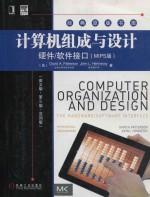

Computer organization and design the hardware/software interface Fifth Edition Asian Edition = 计算机组成PDF电子书下载
- 电子书积分:19 积分如何计算积分?
- 作 者:David A. Patterson ; John L. Hennessy
- 出 版 社:China Machine Press
- 出版年份:2014
- ISBN:7111453161
- 页数:686 页
CHAPTERS 2
1Computer Abstractions and Technology 2
1.1 Introduction 3
1.2 Eight Great Ideas in Computer Architecture 11
1.3 Below Your Program 13
1.4 Under the Covers 16
1.5 Technologies for Building Processors and Memory 24
1.6 Performance 28
1.7 The Power Wall 40
1.8 The Sea Change:The Switch from Uniprocessors to Multiprocessors 43
1.9 Real Stuff:Benchmarking the Intel Core i7 46
1.10 Fallacies and Pitfalls 49
1.11 Concluding Remarks 52
1.12 Historical Perspective and Further Reading 54
1.13 Exercises 54
2Instructions:Language of the Computer 60
2.1 Introduction 62
2.2 Operations of the Computer Hardware 63
2.3 Operands of the Computer Hardware 66
2.4 Signed and Unsigned Numbers 73
2.5 Representing Instructions in the Computer 80
2.6 Logical Operations 87
2.7 Instructions for Making Decisions 90
2.8 Supporting Procedures in Computer Hardware 96
2.9 MIPS Addressing for 32-Bit Immediates and Addresses 106
2.10 Parallelism and Instructions:Synchronization 116
2.11 Translating and Starting a Program 118
2.12 A C Sort Example to Put It All Together 126
2.13 Advanced Material:Compiling C 134
2.14 Real Stuff:ARMv7(32-bit) Instructions 134
2.15 Real Stuff:x86 Instructions 138
2.16 Real Stuff:ARMv8(64-bit) Instructions 147
2.17 Fallacies and Pitfalls 148
2.18 Concluding Remarks 150
2.19 Historical Perspective and Further Reading 152
2.20 Exercises 153
3Arithmetic for Computers 164
3.1 Introduction 166
3.2 Addition and Subtraction 166
3.3 Multiplication 171
3.4 Division 177
3.5 Floating Point 184
3.6 Parallelism and Computer Arithmetic:Subword Parallelism 210
3.7 Real Stuff:Streaming SIMD Extensions and Advanced Vector Extensions in x86 212
3.8 Going Faster:Subword Parallelism and Matrix Multiply 213
3.9 Fallacies and Pitfalls 217
3.10 Concluding Remarks 220
3.11 Historical Perspective and Further Reading 224
3.12 Exercises 225
4The Processor 230
4.1 Introduction 232
4.2 Logic Design Conventions 236
4.3 Building a Datapath 239
4.4 A Simple Implementation Scheme 247
4.5 An Overview of Pipelining 260
4.6 Pipelined Datapath and Control 274
4.7 Data Hazards:Forwarding versus Stalling 291
4.8 Control Hazards 304
4.9 Exceptions 313
4.10 Parallelism via Instructions 320
4.11 Real Stuff:The ARM Cortex-A8 and Intel Core i7 Pipelines 332
4.12 Going Faster:Instruction-Level Parallelism and Matrix Multiply 339
4.13 Advanced Topic:An Introduction to Digital Design Using a Hardware Design Language to Describe and Model a Pipeline and More Pipelining Illustrations 342
4.14 Fallacies and Pitfalls 343
4.15 Concluding Remarks 344
4.16 Historical Perspective and Further Reading 345
4.17 Exercises 345
5Large and Fast:Exploiting Memory Hierarchy 360
5.1 Introduction 362
5.2 Memory Technologies 366
5.3 The Basics of Caches 371
5.4 Measuring and Improving Cache Performance 386
5.5 Dependable Memory Hierarchy 406
5.6 Virtual Machines 412
5.7 Virtual Memory 415
5.8 A Common Framework for Memory Hierarchy 442
5.9 Using a Finite-State Machine to Control a Simple Cache 449
5.10 Parallelism and Memory Hierarchies:Cache Coherence 454
5.11 Parallelism and Memory Hierarchy:Redundant Arrays of Inexpensive Disks 458
5.12 Advanced Material:Implementing Cache Controllers 458
5.13 Real Stuff:The ARM Cortex-A8 and Intel Core i7 MemoryHierarchies 459
5.14 Going Faster:Cache Blocking and Matrix Multiply 463
5.15 Fallacies and Pitfalls 466
5.16 Concluding Remarks 470
5.17 Historical Perspective and Further Reading 471
5.18 Exercises 471
6Parallel Processors from Client to Cloud 488
6.1 Introduction 490
6.2 The Difficulty of Creating Parallel Processing Programs 492
6.3 SISD,MIMD,SIMD,SPMD,and Vector 497
6.4 Hardware Multithreading 504
6.5 Multicore and Other Shared Memory Multiprocessors 507
6.6 Introduction to Graphics Processing Units 512
6.7 Clusters,Warehouse Scale Computers,and Other Message-Passing Multiprocessors 519
6.8 Introduction to Multiprocessor Network Topologies 524
6.9 Communicating to the Outside World:Cluster Networking 527
6.10 Multiprocessor Benchmarks and Performance Models 528
6.11 Real Stuff:Benchmarking Intel Core i7 versus NVIDIA Tesla GPU 538
6.12 Going Faster:Multiple Processors and Matrix Multiply 543
6.13 Fallacies and Pitfalls 546
6.14 Concluding Remarks 548
6.15 Historical Perspective and Further Reading 551
6.16 Exercises 551
APPENDICES? 564
A Assemblers,Linkers,and the SPIM Simulator 564
A.1 Introduction 565
A.2 Assemblers 572
A.3 Linkers 580
A.4 Loading 581
A.5 Memory Usage 582
A.6 Procedure Call Convention 584
A.7 Exceptions and Interrupts 595
A.8 Input and Output 600
A.9 SPIM 602
A.10 MIPS R2000 Assembly Language 607
A.11 Concluding Remarks 643
A.12 Exercises 644
B TH-2 High Performance Computing System 646
B.1 Introduction 647
B.2 Compute Node 647
B.3 The Frontend Processors 649
B.4 The Interconnect 650
B.5 The Software Stack 651
B.6 LINPACK Benchmark Run(HPL) 651
B.7 Concluding Remarks 652
F Networks-on-Chip 654
F1 Introduction 655
F2 Communication Centric Design 655
F3 The Design Space Exploration of NoCs 657
F4 Router Micro-architecture 660
F5 Performance Metric 661
F6 Concluding Remarks 661
Index 663
- 《计算机网络与通信基础》谢雨飞,田启川编著 2019
- 《大学计算机实验指导及习题解答》曹成志,宋长龙 2019
- 《卓有成效的管理者 中英文双语版》(美)彼得·德鲁克许是祥译;那国毅审校 2019
- 《计算机辅助平面设计》吴轶博主编 2019
- 《计算机组成原理解题参考 第7版》张基温 2017
- 《云计算节能与资源调度》彭俊杰主编 2019
- 《Helmholtz方程的步进计算方法研究》李鹏著 2019
- 《AutoCAD 2018自学视频教程 标准版 中文版》CAD/CAM/CAE技术联盟 2019
- 《跟孩子一起看图学英文》张紫颖著 2019
- 《计算机组成原理 第2版》任国林 2018
- 《数据失控》(美)约翰·切尼-利波尔德(John Cheney-Lippold)著 2019
- 《模型与认知》(美)乔纳森·A.瓦斯肯著,魏刘伟译 2019
- 《地球简史》(英)戴维·贝克(David Baker) 2020
- 《第三帝国的兴亡》(英)克里斯·毕晓普(Chris Bishop),(英)戴维·乔丹(David Jordan)著 2019
- 《图解轻武器史 剑、矛和锤》(美)大卫·苏德(David Soud)著;刘恒沙译 2017
- 《现代环境主义导论》(英)戴维·佩珀(David Pepper)著 2020
- 《深奥的简洁》(英)约翰·格里宾(John Gribbin)著 2020
- 《中国经学史》(美)韩大伟(David B. Honey)著 2019
- 《火星生命 前往须知》(美)戴维·温特劳布(DAVID A. WEINTRAUB)著;傅承启译 2019
- 《铸造手册大全 金属铸造工艺、冶金技术和设计 第6册 熔炼·造型·铸造·凝固》John Campbell主编 2018
- 《R语言机器学习 原书第2版=MACHINE LEARNING USING R WITH TIME SERIES AND INDUSTRY-BASED USE CASES IN R》SECOND EDITION
- 《机器学习实战 基于SOPHON平台的机器学习理论与实践=MACHINE LEARNING IN ACTION PRINCIPLES AND PRACTICE BASED ON TH》星环科技人工智能平台团队编著 2020
- 《竞争战略 全译珍藏版》(美)迈克尔·波特(Michael E. Porter)著 2012
- 《网络互联技术手册 第2版》(美)(K.唐斯)Kevin Downes等著;包晓露等译 1999
- 《新版交换式以太网和快速型以太网 第2版》(美)(R.布雷耶)Robert Breyer,(美)(S.赖利)Sean Riley著;肖文贵等译 1997
- 《摄影100关键词》(英)克拉克著 2011
- 《数控技术专业英语》高成秀主编 2010
- 《守望百年 中英文对照爱情长诗》蔡丽双著;张智中译 2014
- 《环境政策概要》(英)卡罗琳·斯奈尔(Carolyn Snell)著;宋伟译 2017
- 《驼铃 中-英-波兰文对照诗集》蔡丽双著;张智中,(波兰)博古米娜·雅尼卡译 2015
